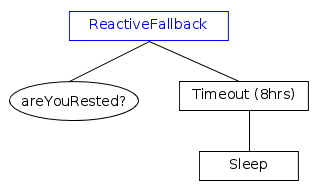BehaviorTree.CPP行为树BT的选择节点(四)
Fallback
该节点家族在其他框架中被称为“选择器Selector”或“优先级Priority”。
他们的目的是尝试不同的策略,直到找到可行的策略。
它们具有以下规则:
tick第一个孩子之前,节点状态为RUNNING。- 如果子节点返回
FAILURE,则后备会tick下一个节点。 - 如果最后一个子节点也返回
FAILURE,则所有子节点都将暂停,并且序列将返回FAILURE。 - 如果子节点返回
SUCCESS,它将停止并返回SUCCESS。 所有的子节点都停止了。
当孩子返回RUNNING时,Fallback的两个版本的反应方式不同:
FallbackStar将返回RUNNING,并且下次对其进行tick时,它将在之前停止的那个节点上tick。- 普通的旧
Fallback会返回RUNNING,并且每次执行后都会重置下一个要执行的子级的索引。
Fallback
在此示例中,我们尝试不同的策略来打开大门。 首先(和一次)检查门是否打开。

// index is initialized to 0 in the constructor
status = RUNNING;
while( _index < number_of_children )
{
child_status = child[index]->tick();
if( child_status == RUNNING ) {
// Suspend execution and return RUNNING.
// At the next tick, _index will be the same.
return RUNNING;
}
else if( child_status == FAILURE ) {
// continue the while loop
_index++;
}
else if( child_status == SUCCESS ) {
// Suspend execution and return SUCCESS.
HaltAllChildren();
_index = 0;
return SUCCESS;
}
}
// all the children returned FAILURE. Return FAILURE too.
index = 0;
HaltAllChildren();
return FAILURE;
ReactiveFallback
如果先前条件之一将其状态从FAILURE更改为SUCCESS,则当您想中断异步子项时,将使用此ControlNode:ReactiveFallback。
在以下示例中,如果角色充分休息,则该角色最多可睡8个小时或更短的时间。

伪代码
// index is initialized to 0 in the constructor
status = RUNNING;
for (int index=0; index < number_of_children; index++)
{
child_status = child[index]->tick();
if( child_status == RUNNING ) {
return RUNNING;
}
else if( child_status == FAILURE ) {
// continue the while loop
index++;
}
else if( child_status == SUCCESS ) {
// Suspend execution and return SUCCESS.
// At the next tick, index will be the same.
HaltAllChildren();
return SUCCESS;
}
}
// all the children returned FAILURE. Return FAILURE too.
index = 0;
HaltAllChildren();
return FAILURE;


 浙公网安备 33010602011771号
浙公网安备 33010602011771号